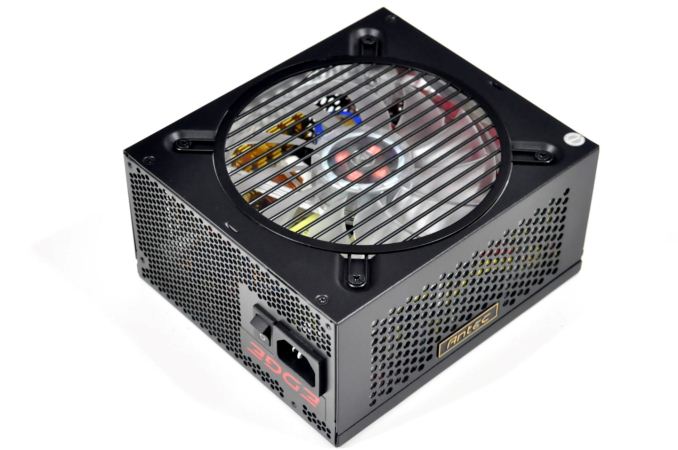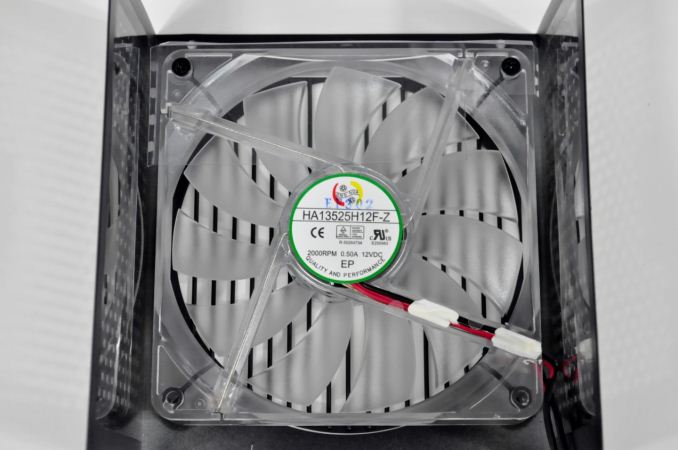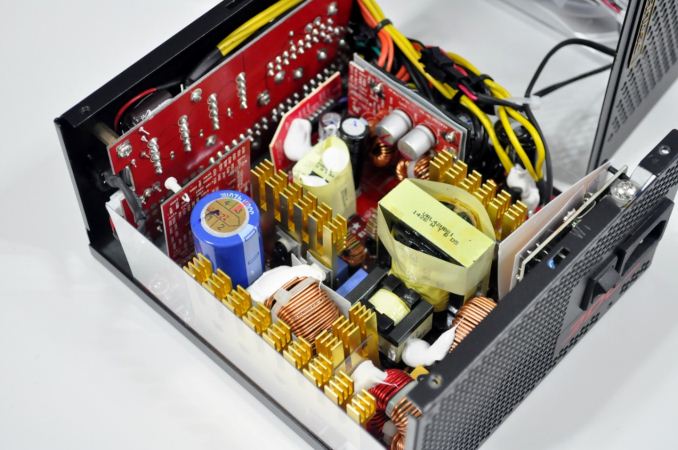Antec EDGE 550W Power Supply Review
by E. Fylladitakis on October 3, 2014 10:00 AM EST- Posted in
- Cases/Cooling/PSUs
- Antec
- 550W
- Edge
External Appearance
Visually, the Antec EDGE 550W certainly stands out from the crowd. Actively cooled units with perforated sides are rare to begin with, let alone units with an output of just 550W. This is likely to be more of a decorative measure than anything needed for cooling, as a large portion of the openings are blocked by the plastic shielding. Despite the output, the chassis of the Edge is 170mm long, making it slightly longer than a standard ATX unit and that could pose a problem in very tight compartments.
Antec made numerous small modifications to enhance the appearance of the unit, including a parallel grid fan guard, badges on the sides and rear of the chassis, and a semi-transparent white LED fan. The badges on the sides are installed in such a way that their orientation when looking at the unit from a left side panel window will be correct, regardless of whether the unit has been installed with the fan facing upwards or downwards. On the front side of the chassis are the connectors for the modular cables, as well as a switch that can turn the LED lighting off.
Internal Design
The 135mm semi-transparent fan is supplied by Hong Hua, a common supplier of fans for use in PSUs. It has a fluid dynamic bearing engine and a maximum speed of 2000RPM. Our instrumentation reports a maximum unobstructed volume flow of 70.5CFM.
Seasonic is the company behind the creation of the Antec's EDGE series. The EDGE shares the same platform as the Seasonic S12G but there are notable differences in the selection of components. There are four heatsinks, with the smallest one holding the primary rectifier bridge, the one near the edge of the PCB the active PFC components, and those on each side of the main transformer handle the inversion and conversion transistors of the primary and secondary stage respectively.
A small shielded PCB is attached to the rear of the AC receptacle, housing some of the filtering stage components, while the rest can be found on the main PCB. There are a total of six Y capacitors, two X capacitors and two filtering inductors, which are more than adequate for a good filtering stage. Moving towards the APFC stage, we see the blue Hitachi 330μF/420V capacitor next to a large filtering coil that has been drenched in glue. The rest of the capacitors are a mix of Nippon Chemi-Con and Rubycon electrolytics, as well as many polymer capacitors from Enesol.
The build quality of the Antec EDGE 550W is outstanding. Not only is the soldering job flawless, but the factory also performed an excellent assembly job. Glue has been applied on all critical components, ensuring the mechanical cohesion of the unit and minimizing the risk of high frequency vibration noises (also known as "coil whine"). Plastic sheets and pins ensure that no component will short another. Our only complaint lies with the design. As this platform has not really been developed purely for fully modular designs, there are a lot of cables causing some clutter near the left edge of the unit.

























25 Comments
View All Comments
bsim500 - Friday, October 3, 2014 - link
Good review but I really don't understand the point of a low-mid wattage PSU that's 170mm in length when other brands on the market are only 140mm? Doesn't the target market for these also go hand in hand with compact short depth Micro-ATX cases?...PS: How about a roundup on the really low wattage stuff for increasingly popular Mini-ITX builds (ie, 40-160w "Pico-PSU"), and maybe Seasonic G360 (budget, Gold rated, 140mm length, ultra quiet) / X400 (totally fanless), etc, which are all a lot more interesting from a custom build HTPC / "netbox" perspective?
willis936 - Friday, October 3, 2014 - link
Well at this point the target market is everyone who isn't running SLI or an overclocked HEDT CPU. In most cases (figurative and literal) the smaller PSU is nice but some people still do mid ATX cases with ATX mobos rather than uATX so I guess this is the PSU for them.willis936 - Friday, October 3, 2014 - link
Also after looking at price and results I can't see why anyone would forgo a SS PSU if they care about sound and performance at this price.Bobsy - Friday, October 3, 2014 - link
Well, it this is indeed based on the SeaSonic S12G, then it's like a S12G but modular, for almost the same price. I can easily see how this can be appealing.bebimbap - Friday, October 3, 2014 - link
I believe the size is due to the "silence" of the PSU.smaller/compact PSUs would be harder to cool with no/less air flow.
I have the seasonic G360 it is a beast. even with a highly oc'd 4770k @4.5ghz and gtx 670 oc'd to 1250 with boost. it doesn't have a single hickup. but that said, Most workloads are either high GPU with low cpu load (gaming) or the opposite no gpu and high cpu load. Not many workloads can max out a 4core with HT AND a upper tier GPU. So in the end i'm sure i won't hit the 360w limit. But I too would be interested in small PSUs in the 40-160w range.
TelstarTOS - Saturday, October 4, 2014 - link
There are more and more people that wants a quiet computing, and use midtower or even full tower cases where space is NOT an issue. It's a trend that Antec chimed in.kmmatney - Monday, October 6, 2014 - link
Yep - that's I I still have my huge Antec P182 case, with sound deadening panels. While I prefer shorter PSUs, I prefer silence even more, and with a large case it doesn't matter what I use. I've been using a Corsair 650W PSU for the last 6 years, which for all intents and purposes, is dead silent.The_Assimilator - Saturday, October 4, 2014 - link
This PSU utilizes the S12G platform, which is not designed for modularity. Hence additional space was needed for the modular cables' PCB.JoBalz - Friday, November 7, 2014 - link
Definitely one where you'll want to measure your available CPU space before ordering. Some cases the length would be a definite problem. I think I could get it physically in my case but having to attach or remove cables might be the problem as it's push up pretty close to the hard drive bays in the front of the case. Otherwise, it sounds like a good unit and a good price for most mainstream users that don't overclock and that have only one GPU to power.JoBalz - Friday, November 7, 2014 - link
Excuse me, I meant to measure your available PSU space before ordering (particularly if you're replacing an existing unit),.